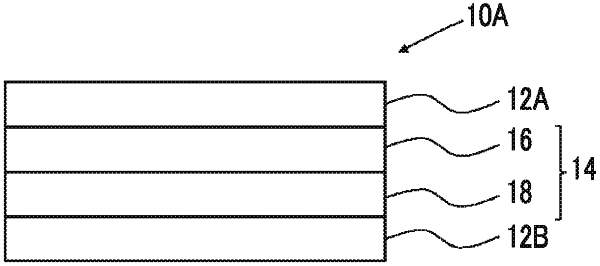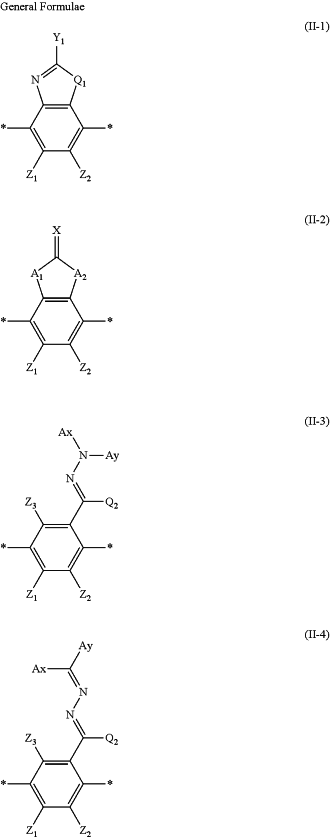| CPC C09K 19/3861 (2013.01) [G02B 5/3016 (2013.01); G02F 1/13363 (2013.01); G02F 1/133528 (2013.01); C09K 2019/0448 (2013.01); C09K 2323/031 (2020.08); C09K 2323/06 (2020.08); C09K 2323/061 (2020.08); G02F 1/133565 (2021.01); G02F 1/133638 (2021.01); H01L 27/3232 (2013.01)] | 20 Claims |

|
1. A laminate comprising:
two substrates; and
only one polarizing plate disposed between the two substrates,
wherein the polarizing plate has a polarizer and an optically anisotropic layer,
the polarizer contains a polyvinyl alcohol-based resin,
the optically anisotropic layer is formed of a composition containing a polymerizable liquid crystal compound represented by General Formula (I),
an end surface of the optically anisotropic layer is in contact with an outside air,
a moisture permeability of the substrate is 10−3 g/m2·day or less,
measurement of the moisture permeability of the substrate is performed using a water vapor permeability measuring device (AQUATRAN 2 (registered trademark) manufactured by MOCON, INC.) under conditions of a measuring temperature of 40° C. and a relative humidity of 90%,
a water content of the polarizing plate is 3.0 g/m2 or less,
the water content of the polarizing plate is obtained by converting a change amount between an initial mass of the polarizing plate which is a measurement target and a dry mass of the polarizing plate after drying at 120° C. for 2 hours per unit area, and
L1-G1-D1-Ar-D2-G2-L2 (I)
in General Formula (I), D1 and D2 each independently represent a single bond, —O—, —CO—O—, —C(═S)O—, —CR1R2, —CR1R2—CR3R4—, —O—CR1R2—, —CR1R2—O—CR3R4—, —CO—O—CR1R2—, —O—CO—CR1R2—, —CR1R2—CR3R4—O—CO—, —CR1R2—O—CO—CR3R4—, —CR1R2—CO—O—CR3R4—, —NR1—CR2R3—, or —CO—NR1—,
where R1, R2, R3, and R4 each independently represent a hydrogen atom, a fluorine atom, or an alkyl group having 1 to 4 carbon atoms;
G1 and G2 each independently represent an alicyclic hydrocarbon group or an aromatic hydrocarbon group, which has 5 to 8 carbon atoms and is divalent, and a methylene group contained in the alicyclic hydrocarbon group may be substituted with —O—, —S—, or —NH—;
L1 and L2 each independently represent a monovalent organic group, and at least one selected from the group consisting of L1 and L2 represents a monovalent group having a polymerizable group; and
Ar represents a divalent aromatic ring group represented by General Formula (II-1), General Formula (II-2), General Formula (II-3), or General Formula (II-4),
 in General Formulae (II-1) to (II-4), Q1 represents —S—, —O—, or —NR11—, R11 represents a hydrogen atom or an alkyl group having 1 to 6 carbon atoms, Y1 represents an aromatic hydrocarbon group having 6 to 12 carbon atoms or an aromatic heterocyclic group having 3 to 12 carbon atoms, Z1, Z2, and Z3 each independently represent a hydrogen atom, an aliphatic hydrocarbon group having 1 to 20 carbon atoms, an alicyclic hydrocarbon group having 3 to 20 carbon atoms, a monovalent aromatic hydrocarbon group having 6 to 20 carbon atoms, a halogen atom, a cyano group, a nitro group, —NR12R13, or —SR12, Z1 and Z2 may be bonded to each other to form an aromatic ring or an aromatic heterocyclic ring, R12 and R13 each independently represent a hydrogen atom or an alkyl group having 1 to 6 carbon atoms, A1 and A2 are each independently a group selected from the group consisting of —O—, —NR21—, —S—, and —CO—, where R21 represents a hydrogen atom or a substituent, X represents a hydrogen atom or a non-metallic atom of Group 14 to Group 16, to which a substituent may be bonded, Ax represents an organic group having 2 to 30 carbon atoms, which has at least one aromatic ring selected from the group consisting of an aromatic hydrocarbon ring and an aromatic heterocyclic ring, Ay represents a hydrogen atom, an alkyl group having 1 to 6 carbon atoms, which may have a substituent, or an organic group having 2 to 30 carbon atoms, which has at least one aromatic ring selected from the group consisting of an aromatic hydrocarbon ring and an aromatic heterocyclic ring, the aromatic rings in Ax and Ay may each have a substituent, Ax and Ay may be bonded to each other to form a ring, and Q2 represents a hydrogen atom or an alkyl group having 1 to 6 carbon atoms, which may have a substituent.
|